Calendar of nature for the second junior group. Design of the corner "Calendar of Nature" for all age groups
Natasha Meleshkina
It is a methodological game guide. Designed to systematically observe seasonal changes nature
Corresponds to GEF DOE and provides the content of the program in the field « cognitive development» . Reflects one aspect educational environment, i.e., directly, the subject-spatial developing environment.
Calendar consists of a stand in the form of a platform with a multi-colored fence. The planks on the fence are painted in the colors of the rainbow and symbolize the days of the week. From 4-5 weeks (they are symbolized by cones - weeks in a row) consists of a month, which is a house with a roof made of flannelgraph. In the house they gather and live all the weeks - another month. Each day is also fixed in number and displayed on the pediment of the house. Months gather in the clearing (circle divided into conditional seasons and months). Next to the house "growing" the tree in which all the months gather in the seasons. The tree consists of 4 parts: autumn winter spring Summer. The tree is on a substrate in the form of a circle. Divided into four seasons, and seasons by months. Thus, visually, starting from the day of the week, in calendar going all year round. To get acquainted with the months, there is an application in the form of folders that contain information about the months of the year (poems, riddles, sayings, signs).
This game guide is intended for children from 5 years old. It can be used by the teacher as part of the GCD, in joint activities with children, as well as for independent play in a group.
A set of methodological aids.
Playground with a fence and a type-setting panel (for illustrations of the seasons ... 1 pc
House…. 1 PC
Wood…. 1 PC
Stand-circle with the name of the seasons ... 1 pc
A set of names of months and numbers….1pc
Cone with the name of the order of the week ... .5 pcs
Explanatory note.
Designed to systematically observe seasonal changes nature, orientation by days, weeks, months, seasons and familiarity with time.
The purpose of this manual is not only to provide knowledge about seasonal changes in nature but also to develop mental activity: perception and thinking, observation, steady cognitive interest, memory, perception and thinking. In the course of working with calendar tasks such as how: shaping elementary representations about phenological phenomena nature. Children learn to compare, contrast and establish the cause and temporal dependence of phenomena. Familiarity with the rules of conduct in nature. Education of love and respect for nature.
By using calendar kids visually, in an accessible game form throughout the year determine the year, season, month, day of the week and day of the month; as well as through applications (folders by months of the year) children learn how the weather changes as the seasons change; what happens in the plant and animal world; what happens in human activity. Communication with « nature calendar» develops children: visual and auditory attention and perception; observation and thinking; curiosity; vocabulary and connected speech; fine motor skills of the hands. Observing changes with children nature on walks contribute: versatile development of the child; education of love and respect for plants and animals; the emergence of positive emotions, good mood and inspiration. Benefit addressed to: for teachers to work with children, starting from the age of 5 summer age. The manual presents a model for organizing the educational and joint activities of a teacher, developed in accordance with the Federal State Educational Standards based on practical experience in familiarizing children with natural world and aimed at the formation of a natural-scientific worldview, ecological thinking and healthy lifestyle life. The tasks of the educational field "Knowledge" are solved in an integrated way in the course of mastering educational regions: "Health", "Safety", "Socialization", "Communication", "Reading fiction". The planned results of the development of integrative qualities have been determined, which will ensure the full development, education and upbringing of preschool children. In the course of implementing the goals and objectives, the following subject areas should be achieved results:
children know:
1) the names of the days of the week, months, seasons;
2) the seasons according to their phenomena and signs;
3) symbols when working with nature's calendar
children can:
1) identify and name the days of the week,
2) determine the sequence of weeks
3) make a month out of a certain number of weeks
4) make up the season from "months"
5) make up a year from "seasons"
6) make observations and fill calendar individually and subgroup;
4) conduct long-term and short-term observations;
filling nature calendar in the preschool educational institution - an important joint practical activity, during which the teacher teaches children to find the necessary designations for the days of the week, weeks, months, seasons, year. Teaches children how to use and understand symbols. prefabricated information calendar located right in the corner nature and fills up every day.
At the first stage, this happens together with the teacher, then those who can independently arrange the necessary names and numbers are selected from the children.
Can be used in special thematic classes to get acquainted with the outside world, nature, acquaintance with lexical topics (seasons, public dates and holidays, people's clothes, wild animals, etc.) It is very important to evoke a positive attitude towards objects and phenomena in a child nature. The most effective means for this will be frequent, direct observations.
The sequence of acquaintance and filling calendar.
Master class "Calendar of nature in quilling technique"
Author: Buzilova Elena Argadievna, educator, MBDOU kindergarten of a general developmental type No. 79, Tomsk, Tomsk region.
Material Description: Dear colleagues! I offer you an original idea for decorating a corner on ecology - a nature calendar made using the quilling technique. Such a beautiful calendar of nature will delight children, and they will be happy to determine the weather outside the window.
Progress
On the English language this needlework is called "quilling" - from the word "quill" or "bird feather". Nowadays, paper rolling is widely known and popular as a hobby. To complete this work, you will need colored office paper, glue, ceiling tiles, multifor, velvet colored paper, color printouts of “weather for children” pictures.

To begin with, we will make blanks - multi-colored spirals of colored paper. Colored paper should be cut into strips 5 mm thick along the short side. A strip of quilling paper is twisted into a tight spiral. It will be convenient to start winding by wrapping the edge of the quilling paper tape on the tip of a sharp awl or toothpick. Having formed the core of the spiral, you can feel with your fingertips whether the roll is uniformly formed, and adjust the effort in time. As a result, a tight spiral should form. It will be the basis for the further diversity of all forms. The paper spiral unfolds to the desired size, and then the necessary quilling figure is formed from it.
The tip of the paper is stuck with glue.

Thus, blanks for future compositions are obtained.
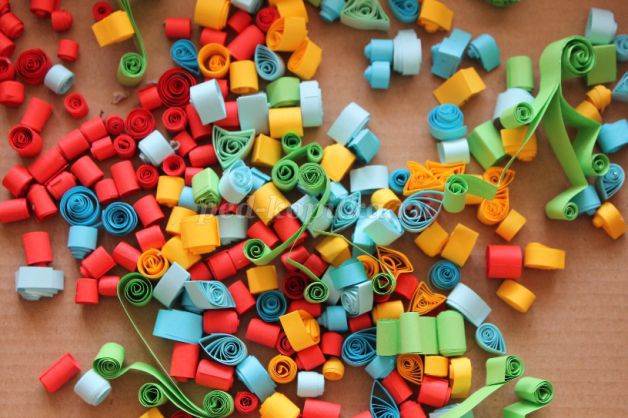
For each season, I created my own sketch. For example, autumn is a bunch of mountain ash with yellow leaves, winter is a snowflake, summer is butterflies, spring is snowdrops. Glue a round backing onto the velvet paper. Then we draw the contours of the future composition and lay out the picture from the prepared spirals, sticking them on the glue.



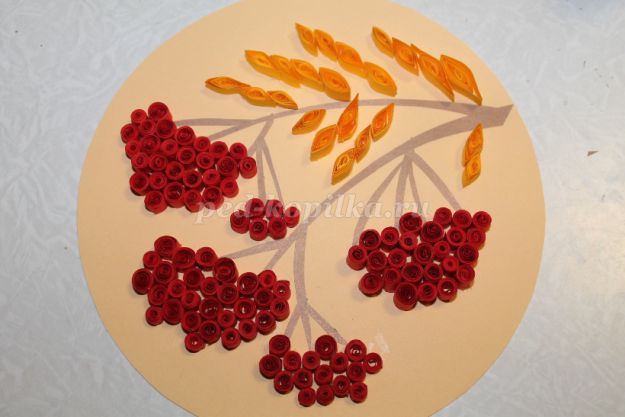
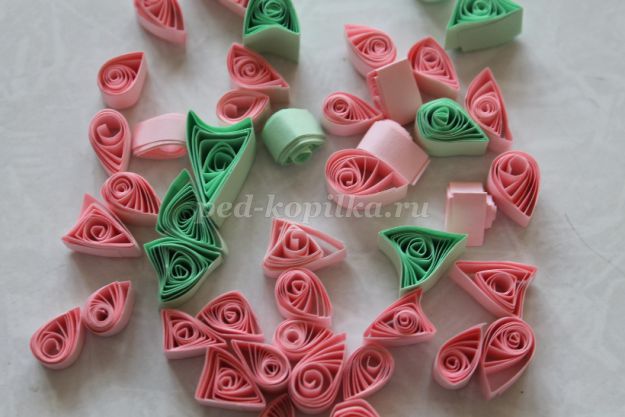
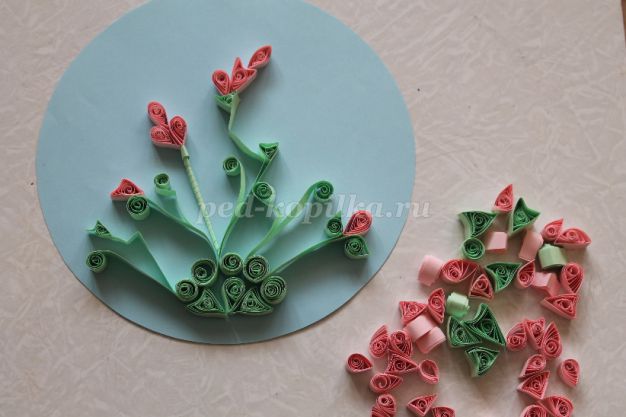

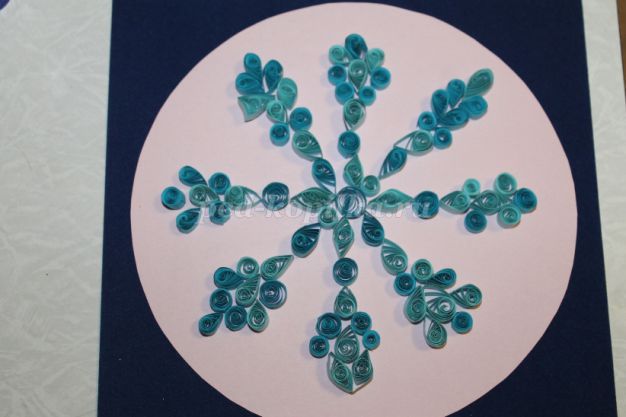
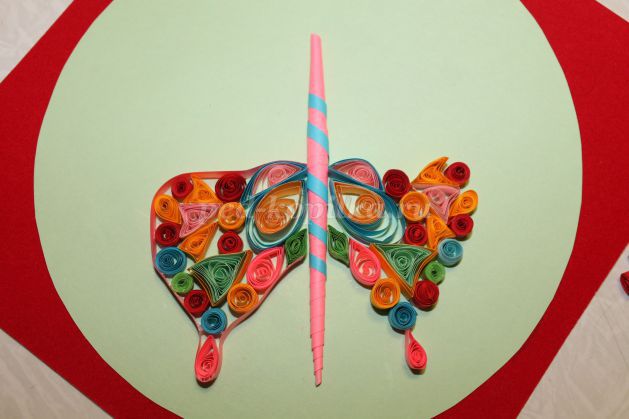
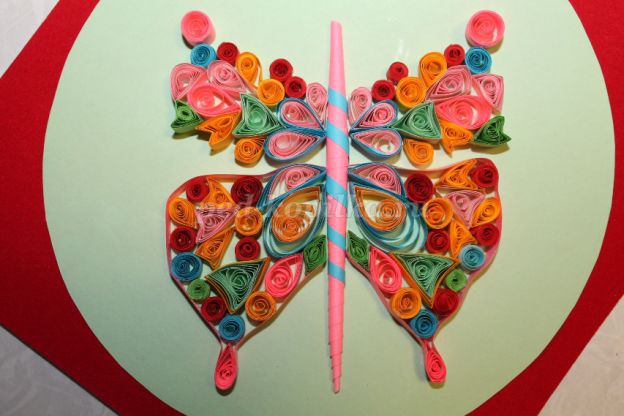
After we have laid out and pasted the figure of a butterfly, we glue it along the contour with a long strip of paper.
According to the GEF program, in each group of the kindergarten, it is necessary to create corners of nature and weather to familiarize children with nature and natural phenomena.
The organization of a corner of nature contributes to:
- development of the ability to establish causal relationships between natural phenomena;
- the formation of primary ideas about the natural diversity of our world;
- the formation of elementary ecological ideas;
- education of the ability to behave in nature;
- education of love for nature and the desire to protect it.
Each teacher approaches the design of a corner of nature in his own way.
But there are generally accepted features of organizing a corner of wildlife:
1. Placement of fresh flowers to consolidate knowledge about herbaceous and indoor plants (balsam, ficus, chlorophytum, geranium, begonia, primrose, etc.); learning how to take care of them.
2. Introducing live animals (budgies, fish, guinea pigs, etc.) to foster love for animals, respect and care for them.
3. Arrangement of a corner for observing natural phenomena to get acquainted with characteristic features successive seasons and the changes that occur in connection with this in the life and activities of adults and children.
If everything is simple and clear with the first two points, then questions arise with the third. How to equip a corner of nature to introduce children to natural phenomena, what information to place there and how to arrange it. In order not to look for answers to these questions and make life easier for educators, some manufacturers of goods for kindergarten have already created ready-made models of nature and weather calendars. They contain all the necessary information and correspond to a certain age group of the child. Thus, the calendars of nature are divided into 2 groups:
For the younger group of kindergarten (from 3 to 4 years old)

Bright, with colorful images of animals and plants, stands that will always attract the attention of children and will stimulate them to the learning process. They usually contain the following information:
- about the seasons (winter, summer, spring, autumn),
- days of the week (Monday-Sunday)
- natural phenomena (rain, wind, sun, etc.)
With the help of a teacher and an observation calendar, children will learn to notice changes in nature: it gets colder, it rains, birds fly to warmer climes; learn to recognize and name the time of year.
For middle and senior groups of kindergarten (from 4 to 6 years old)
Watch video
Colorful observation calendars that contain everything you need to study natural phenomena in older kindergarten groups.
As a rule, the set of such calendars includes special plates that the teacher inserts into acrylic pockets during the lesson (day of the week, date, month, year, holidays, etc.).

Many models contain interactive thermometers that children love and enliven the course of the lesson. By moving the slider, children will learn concepts such as "cold-hot", "cool-warm".

Currently, more modern models of nature calendars are being produced, which are preferred by many teachers. These are magnetic-marker observation calendars.

They are interesting in that by writing data on the marker surface, you can keep a diary of weather observations right in your group. So, in a clear way, together with the children there is an opportunity to spend comparative analysis data for today and yesterday, for today and last Monday, etc.
Example:
Children, what is the weather like today? Let's look out the window and see.
- The sun is shining and warm.
- Children, what was the weather like yesterday?
— It was cooler than today and it was raining.
Thus, children will learn to notice and name changes in nature: it got colder, precipitation, wind, leaf fall, etc., to establish the simplest connections between the phenomena of living and inanimate nature (it got colder - butterflies disappeared, flowers faded, etc.)
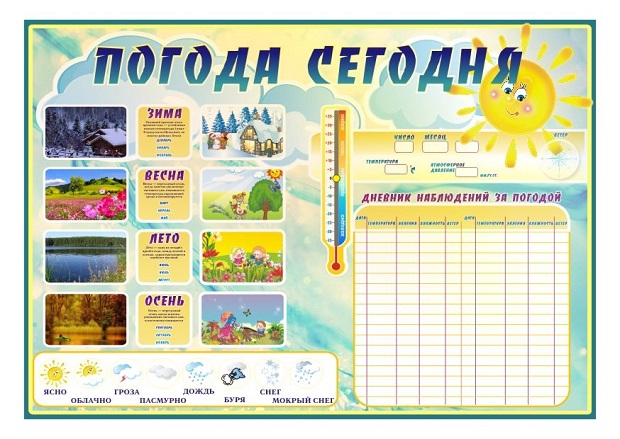
Some models of magnetic-marker nature calendars are sold with children's favorite magnets. They depict clothes that must be worn in this or that weather, public holidays, natural phenomena. Every child will definitely like this element. Who doesn't love magnets!

Also, calendars of nature and weather, which belong to the last group, can be used to work with younger children. school age, as some of them have clocks, which are very convenient to study time.
The main task of the nature calendar is to draw children's attention to nature, to expand and clarify ideas about nature, to teach to observe, to develop curiosity.
For teaching children preschool age Interdesign has developed colorful game wall stands - nature calendars for kindergarten helping children to understand the world around them. The presence of pockets makes nature calendars even more convenient to use - because they can easily accommodate thematic children's drawings, information about the current month, day of the week, weather, etc.
Calendar "Seasons" for preschool
Children's calendar "Seasons" consists of 4 parts, one part for each season. The arrow on the calendar indicates the current season. The bright themed coloring of the calendar allows children to easily match the current season and its display on the "Seasons" calendar for kindergarten.
Buy a nature calendar for kindergarten
In our catalog you will find a wide range of different stands for kindergarten subjects "Calendar of Nature". All stands are made of exclusively high-quality materials, so for a long time they will delight the kids in groups. Bright and colorful, they are perfect for decorating a kindergarten. Here you can buy a stand "Calendar of Nature" from the options presented in the catalog or order production based on your own wishes.
Elena Zubareva
Every day, together with my preschool children, we celebrate changes in nature(season, air temperature, cloudiness, precipitation, wind direction, etc.) nature calendar. Now there are many different nature calendars(printed, magnetic, ready-made stands, but I decided to try to make diy nature calendar. And here's what came of it.
As a basis, I took the usual plastic panels sold in any hardware store and corners. Two-piece panel held together the foundation for the future nature calendar. I designed this field with plastic corners so that the children could not injure their hands. Then I started to create my own calendar. Using a printer, I printed out suitable pictures, laminated them with adhesive tape and carefully pasted them onto the base.
Placed funny letters at the top NATURE CALENDAR with suns and clouds and a symbol of our groups - sunshine.

Then I carefully pasted 3 dials with arrows (seasons and months, weather conditions and precipitation, parts of the day).
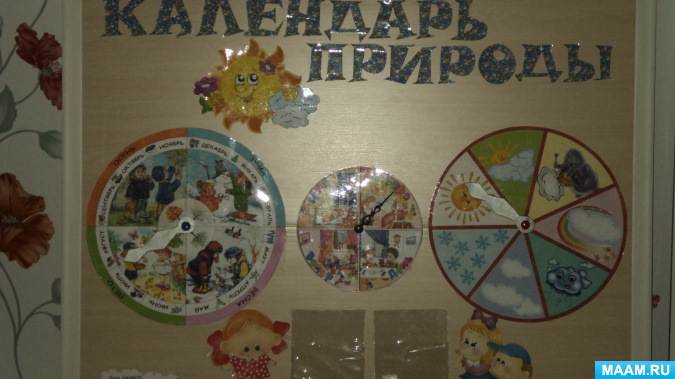
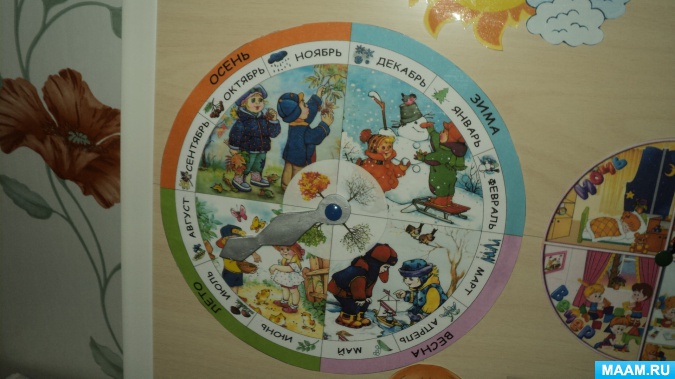
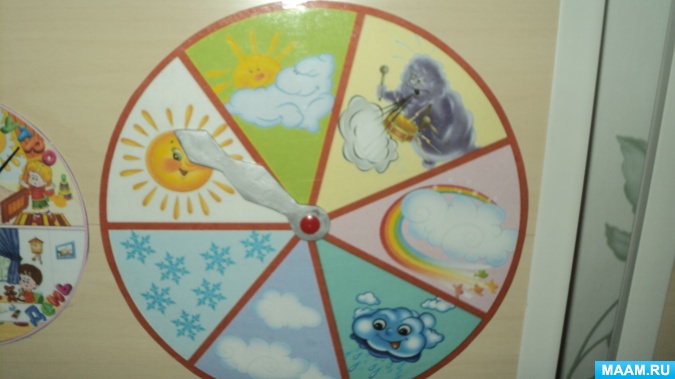

Under them are 2 transparent pockets for cards with the name of the month and date.


And below, I decided to place a funny train with 7 wagons that will help the guys fix the names of the days of the week.

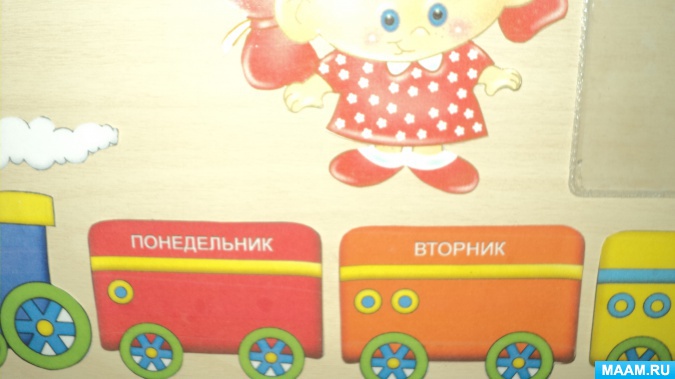
Our calendar really liked the kids. They are pleased to note the changes in nature with its help, they consolidate knowledge about the seasons, parts of the day, days of the week and the characteristic features of the seasons.
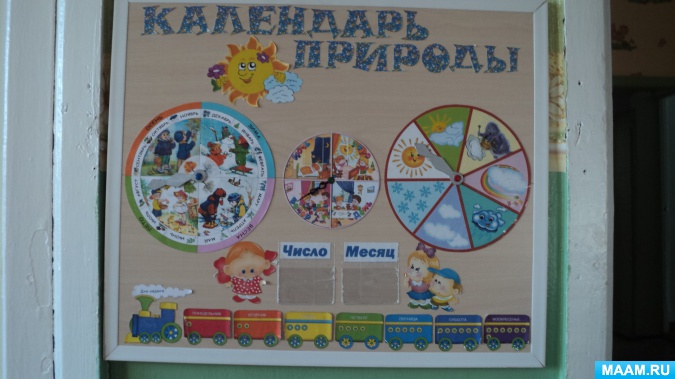

We celebrate the weather every day, day after day
We learn a lot of new things together every day.
Changes in nature we celebrate like old
We come to the rescue of our funny calendar.
Time of the year, day of the week, parts of the day without problems
We can easily identify them and tell everyone about them.
We watch with love nature every day
We are not too lazy to make many secrets, new discoveries.
I will be glad if you like our idea. Thank you for your attention!
Related publications:
From day to day to Everyday life children observe their surroundings. They learn the world in all its manifestations, observe the changes of nature.
Calendar of nature "Luntik". Hello, dear colleagues and guests of the site, today I want to introduce my Luntik nature calendar.






